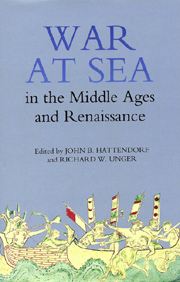Book contents
- Frontmatter
- Contents
- List of illustrations
- List of Contributors
- Preface
- Acknowledgements
- Introduction: Theories of Naval Power: A. T. Mahan and the Naval History of Medieval and Renaissance Europe
- I Northern Europe
- Naval Force in the Viking Age and High Medieval Denmark
- Scandinavian Warships and Naval Power in the Thirteenth and Fourteenth Centuries
- Naval Power and Maritime Technology during the Hundred Years War
- Oars, Sails and Guns: The English and War at Sea, c.1200–c.1500
- II Southern Europe
- III Sixteenth and Early-Seventeenth-Century Europe
- Conclusion: Toward a History of Medieval Sea Power
- Index
- Titles in the series
Scandinavian Warships and Naval Power in the Thirteenth and Fourteenth Centuries
from I - Northern Europe
Published online by Cambridge University Press: 05 April 2013
- Frontmatter
- Contents
- List of illustrations
- List of Contributors
- Preface
- Acknowledgements
- Introduction: Theories of Naval Power: A. T. Mahan and the Naval History of Medieval and Renaissance Europe
- I Northern Europe
- Naval Force in the Viking Age and High Medieval Denmark
- Scandinavian Warships and Naval Power in the Thirteenth and Fourteenth Centuries
- Naval Power and Maritime Technology during the Hundred Years War
- Oars, Sails and Guns: The English and War at Sea, c.1200–c.1500
- II Southern Europe
- III Sixteenth and Early-Seventeenth-Century Europe
- Conclusion: Toward a History of Medieval Sea Power
- Index
- Titles in the series
Summary
AS for many other parts of Europe, the thirteenth and fourteenth centuries were for Denmark a time characterised by internal and external wars. Thanks to its geography, and to the geography of the North Sea and Baltic area in general, seafaring always held an important position in the economics and politics of the country. Ships were needed to tie together the various parts of the country and when wars were fought, naval operations were mandatory. At the same time, Denmark during the eleventh to fourteenth centuries, thanks to its fertile lands and short distances to large north European urban centres, became much more influenced by continental social, economic and political developments than the likewise markedly maritime Scandinavian countries Norway and Sweden. It is therefore of interest to know whether the Danish situation, combining a Scandinavian maritime society with continentally coloured economic and social development, led to the early creation of structures that might foretell the formation of permanent navies like those known from the sixteenth century on.
In investigating this question it has to be admitted that neither the archaeological nor the literary sources provide ample information on maritime warfare and we have to extrapolate from scarce source material when we want to discuss high medieval naval organisation in Denmark. It is possible to attack at least three questions concerning the general issue because of the existence of relevant sources.
- Type
- Chapter
- Information
- War at Sea in the Middle Ages and the Renaissance , pp. 35 - 52Publisher: Boydell & BrewerPrint publication year: 2002

